Sea Mammals
Look No Further
Look no further than the real--
into a piece of abalone shell that sees
like a turtle's eye, steadfast and green,
set in a dark swirled burl of wood
and old as its bowl home.
See that with him is bear and otter and whale
with their tales like different kinds of wind,
or the sun as it changes leaves
and dragonflies glittering on the water,
or the sea changing
under the seabirds' wings.
(©1996 Carol Snyder Halberstadt)
 This artifact has a special
poignancy for me. I bought it at an auction as part of a lot of
Inuit carvings, not knowing what it was. A gentleman sitting next
to me told me it was a Russian whale blubber scraper. He pointed
out the Russian letter carved into its handle, and the exceptional
smoothness of the stone, coated and worn by years of contact with
whales. I am showing it here as an artifact of destruction, for
it was largely the combined massive force and scale of the American,
Russian, Norwegian, and Japanese whaling trade, and the use of
mechanized hunting methods in the 19th and 20th centuries, which
has resulted in the near-extinction of most whale species. The
Inuit and Aleut peoples who hunted whales for subsistence and
survival never carried on a hunt of the scope that endangered
species. This slaughter is still going on today, to supply whale
meat for markets in Japan and other parts of Asia. Norway is also
participating in the hunting of whales, which has no connection
today whatsoever with the subsistence or survival of people in
these countries.
This artifact has a special
poignancy for me. I bought it at an auction as part of a lot of
Inuit carvings, not knowing what it was. A gentleman sitting next
to me told me it was a Russian whale blubber scraper. He pointed
out the Russian letter carved into its handle, and the exceptional
smoothness of the stone, coated and worn by years of contact with
whales. I am showing it here as an artifact of destruction, for
it was largely the combined massive force and scale of the American,
Russian, Norwegian, and Japanese whaling trade, and the use of
mechanized hunting methods in the 19th and 20th centuries, which
has resulted in the near-extinction of most whale species. The
Inuit and Aleut peoples who hunted whales for subsistence and
survival never carried on a hunt of the scope that endangered
species. This slaughter is still going on today, to supply whale
meat for markets in Japan and other parts of Asia. Norway is also
participating in the hunting of whales, which has no connection
today whatsoever with the subsistence or survival of people in
these countries.
You may learn more about the condition of oceanic life and efforts
to protect it at Earthtrust.

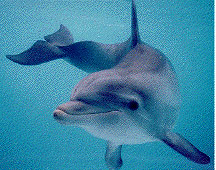
Photos from "Project
Delphis," Dolphin Cognition Research, at Earthtrust
They Became Dolphins
Imagine that predog dog
running to the sea, its feet
shortening for millions of years,
its toes closing,
its body fattened, thick
and sleek with fur flattened
for the shedding of water--
then hear the seal pups barking
and the great grey whales
baying through the deep,
like those ancestor dogs
who became dolphins.
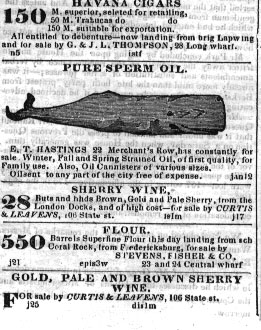
Advertisement for "Pure Sperm Oil," from the Daily
Atlas, Boston, Monday Morning, February 13, 1837, Vol. 5,
Number 198.
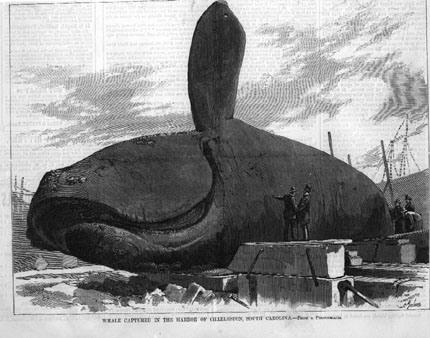 "Whale Captured in the Harbor of Charleston, South
Carolina--From a Photograph," mid-19th century.
"Whale Captured in the Harbor of Charleston, South
Carolina--From a Photograph," mid-19th century.

"The Whale Fishery: The Sperm Whale 'in A Flurry'."
Lithograph by Currier & Ives, 1850s.

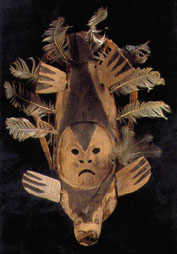
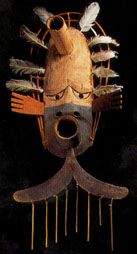
Yup'ik Masks*
Elders talked about the eyes of the hand.
(--Willie Komkoff, Kotlik, Alaska)
When the masks lost their eyes
and were hung on walls unused,
they waited for songs.
Call them--
the eyes of the universe
opening where seals and salmon swim--
Call them--
the owl, loon, the whale
hovering at the sea door--
With your hands shaping a song,
with your hidden face transformed,
through the white stars and the dark
and the dawn gates,
look past
the pretending sky.
With your strong arms
catch
what is real.
*Agayuliyaraput (Our Way of Making Prayer): The Living Tradition of
Yup'ik Masks, National Museum of the American Indian exhibition,
New York, NY, 1997.
The sea otter is another mammal hunted almost to extinction
in the 19th and 20th centuries by Russian and American fur traders.
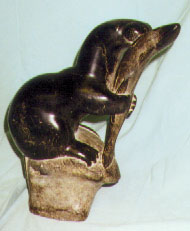
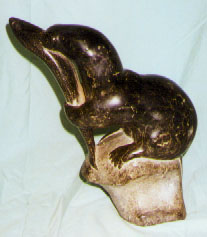
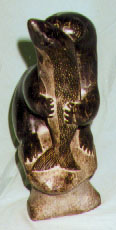
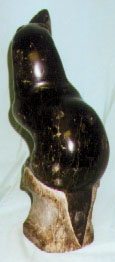
Inuit stone carving of a sea otter with fish, by Lukasi Anauta,
of Povungnituk, ca. 1960s.
Defending the Whale
At their site, there is a full report by Earthtrust on
the 48th Annual International Whaling Commission Conference,
held in Aberdeen, Scotland, June 23-28, 1996. One of the important
reports deals with the opposition by a group of traditional Makah
Indian Elders, of Washington State, to a proposed resumption of
grey whale hunting under tribal auspices.
There are a number of other sites that discuss issues of whale
and sea mammal hunting, particularly of the bowhead whales in
Alaska and Canada. These include:
- The World Wildlife Fund Canadian site on "Bowhead
Whale Facts," which includes discussion and background
on a proposal "by Inuit in Clyde River to establish a bowhead
whale sanctuary on the north coast of Baffin Island."
- The "Bowhead
Whale Home Page," which discusses the bowhead whale
population--where it is threatened and where it is less endangered
(in the Bering-Chukchi-Beaufort Seas).
- The Chukchi Sea Trading Company, in Alaska, with its story
and photo essays about the annual bowhead whale hunt and whale
festival in the Inuit village of Point Hope, Alaska. See the
"Picture Gallery--Point
Hope Scrapbook."
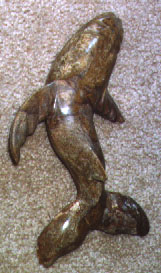
Grey Whales
I have this
coming down to me
as incomprehensible gifts--
arcs of whales moving slowly,
sleeping, slowly,
upright and silent
in their noisy sea,
and waking
to the curve of their flukes
beckoning, slapping,
resounding
on the surface of the deep.
Quinault Basket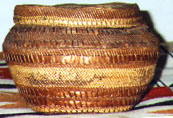 --Cedar Bark
and Bear Grass
--Cedar Bark
and Bear Grass
This cedar bark pictorial lidded basket, 7" high x 10.5"
wide, decorated with two whaleboats, a seabird, and a whale,
and a knitted wool collar, had been on my "for sale"
baskets page, although I never really wanted to sell it. I'm
glad it was out there though, because it was recently seen and
identified by Dr. Arnold N. Troeh, a historian and art appraiser
of Chinook Indian descent. His website had some wonderful material.
He wrote: The Quilleyute People and the Makahs were highly
regarded for their whaling expertise... there was a wonderful
rapport between the aboriginal people and the whale people."
"Speaking of Northwest Coast baskets, it appears you
may have one woven by a very special lady named Mattie Howeattle,
from Taholah, on the Quinault reservation, located on the Olympic
Peninsula of Washington State. When I was in the fifth grade
in 1950, I can remember coming home from the one-room school
in the village and walking into the house where the Quinault
Grandmother weavers were visiting with my Mother, and there on
the floor was seated Mattie Howeattle, with a bowl of water in
front of her, with coils of bear grass soaking, so these strands
would become pliable, so she could use them to weave baskets.
It looks a lot like her work, utilizing the whaling canoes and
sea birds, and that particular ginger jar shape with a lid. There
are other Makah, Quilleyute, Hoh and Queets weavers along the
Washington Coast who used similar materials and designs... On
our site we have a Jewish Sabbath hat [ceremonial head covering]
twined of cedar bark and bear grass, a Yarmulka by Mattie Howeattle,
which was made for a Rabbi when he visited Taholah."
"One winter when a large whale washed up on the beach
she sent her nephew, Nathan Pickernell, out to dance a song of
welcome and respect. We had quite a snowstorm after that, and
people said she was using her spiritual help to influence the
weather."
"There are many traditional Si Si Wis stories and songs
about the sacred cedar trees, and some of our Elders of the Lummi
Tribe, Joe Washington and Isadore Tom, now both deceased, sat
in defiance of a clear-cutting action to save some very special
wisdom trees, old growth cedars that had provided spiritual guidance
to the people for hundreds of years."
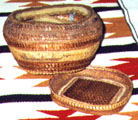
Basket by Mattie Howeattle, Quinault.

Bark from a "grandfather" cedar tree,
Washington State, 1996.
Grandfather Trees
There is a way
that grandfathers watch
children, calm and still,
like trees I've heard of--
old-growth, a canopy
of lives in their heads,
green crowns dense
with moss and lichens.
I've seen old men sitting
compact and wholly at ease,
while children ran and shouted and tumbled.
They were like the few tall pines
on my walks
whose gnarled and knotty bark
held branches
bent and turning to the ground
where ants and beetles make their nests.
And they were men sitting like forests, listening.
All poems from Listening
to the Stone © 1997 Carol Snyder Halberstadt.
Go to Listening to the Stone
pages.
Return to Inuit art page.
Go to Weaving
the Light pages.
Go to Storytelling page.
Return to Migrations home page. 
Write to: Migrations, P.O. Box 543, Newton MA 02456
or email to: carol@migrations.com
to place an order, request photos, or for more information.
Copyright © 1996 -1997 Carol Snyder Halberstadt, Migrations.
All rights reserved.
 This artifact has a special
poignancy for me. I bought it at an auction as part of a lot of
Inuit carvings, not knowing what it was. A gentleman sitting next
to me told me it was a Russian whale blubber scraper. He pointed
out the Russian letter carved into its handle, and the exceptional
smoothness of the stone, coated and worn by years of contact with
whales. I am showing it here as an artifact of destruction, for
it was largely the combined massive force and scale of the American,
Russian, Norwegian, and Japanese whaling trade, and the use of
mechanized hunting methods in the 19th and 20th centuries, which
has resulted in the near-extinction of most whale species. The
Inuit and Aleut peoples who hunted whales for subsistence and
survival never carried on a hunt of the scope that endangered
species. This slaughter is still going on today, to supply whale
meat for markets in Japan and other parts of Asia. Norway is also
participating in the hunting of whales, which has no connection
today whatsoever with the subsistence or survival of people in
these countries.
This artifact has a special
poignancy for me. I bought it at an auction as part of a lot of
Inuit carvings, not knowing what it was. A gentleman sitting next
to me told me it was a Russian whale blubber scraper. He pointed
out the Russian letter carved into its handle, and the exceptional
smoothness of the stone, coated and worn by years of contact with
whales. I am showing it here as an artifact of destruction, for
it was largely the combined massive force and scale of the American,
Russian, Norwegian, and Japanese whaling trade, and the use of
mechanized hunting methods in the 19th and 20th centuries, which
has resulted in the near-extinction of most whale species. The
Inuit and Aleut peoples who hunted whales for subsistence and
survival never carried on a hunt of the scope that endangered
species. This slaughter is still going on today, to supply whale
meat for markets in Japan and other parts of Asia. Norway is also
participating in the hunting of whales, which has no connection
today whatsoever with the subsistence or survival of people in
these countries. 












 --Cedar Bark
and Bear Grass
--Cedar Bark
and Bear Grass

